Lab Report Wastewater Treatment Process
VerifiedAdded on 2023/06/11
|10
|2736
|331
AI Summary
This lab report explains the standard rudiments of the wastewater treatment process. It covers the measurement of purified and raw water, effects of chlorine, measurement of chlorine decay, and more. The report also highlights possible errors and solutions. The second part of the report covers the activated sludge process and its importance in wastewater treatment. It explains the procedure, results, and possible solutions to errors.
Contribute Materials
Your contribution can guide someone’s learning journey. Share your
documents today.
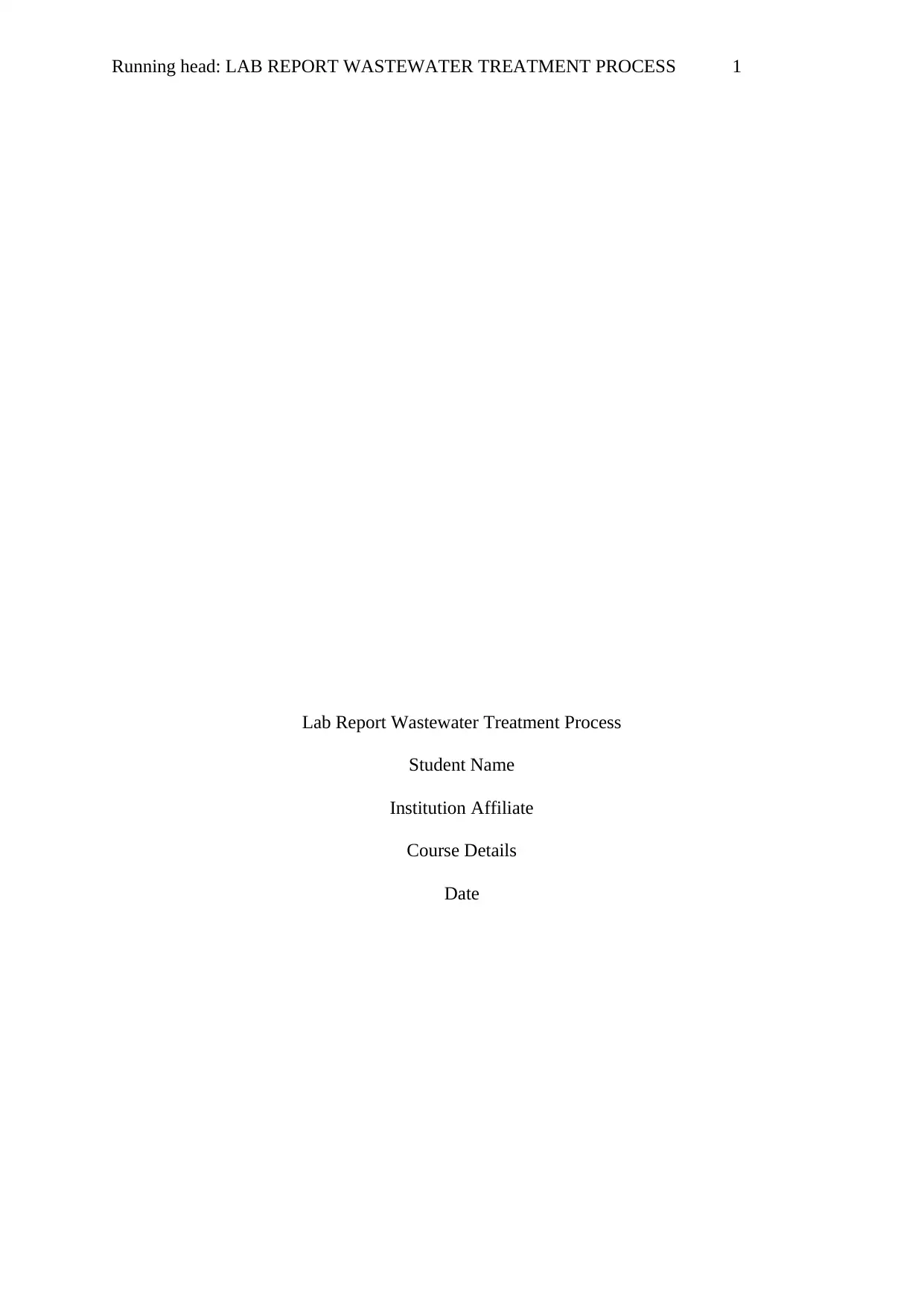
Running head: LAB REPORT WASTEWATER TREATMENT PROCESS 1
Lab Report Wastewater Treatment Process
Student Name
Institution Affiliate
Course Details
Date
Lab Report Wastewater Treatment Process
Student Name
Institution Affiliate
Course Details
Date
Secure Best Marks with AI Grader
Need help grading? Try our AI Grader for instant feedback on your assignments.
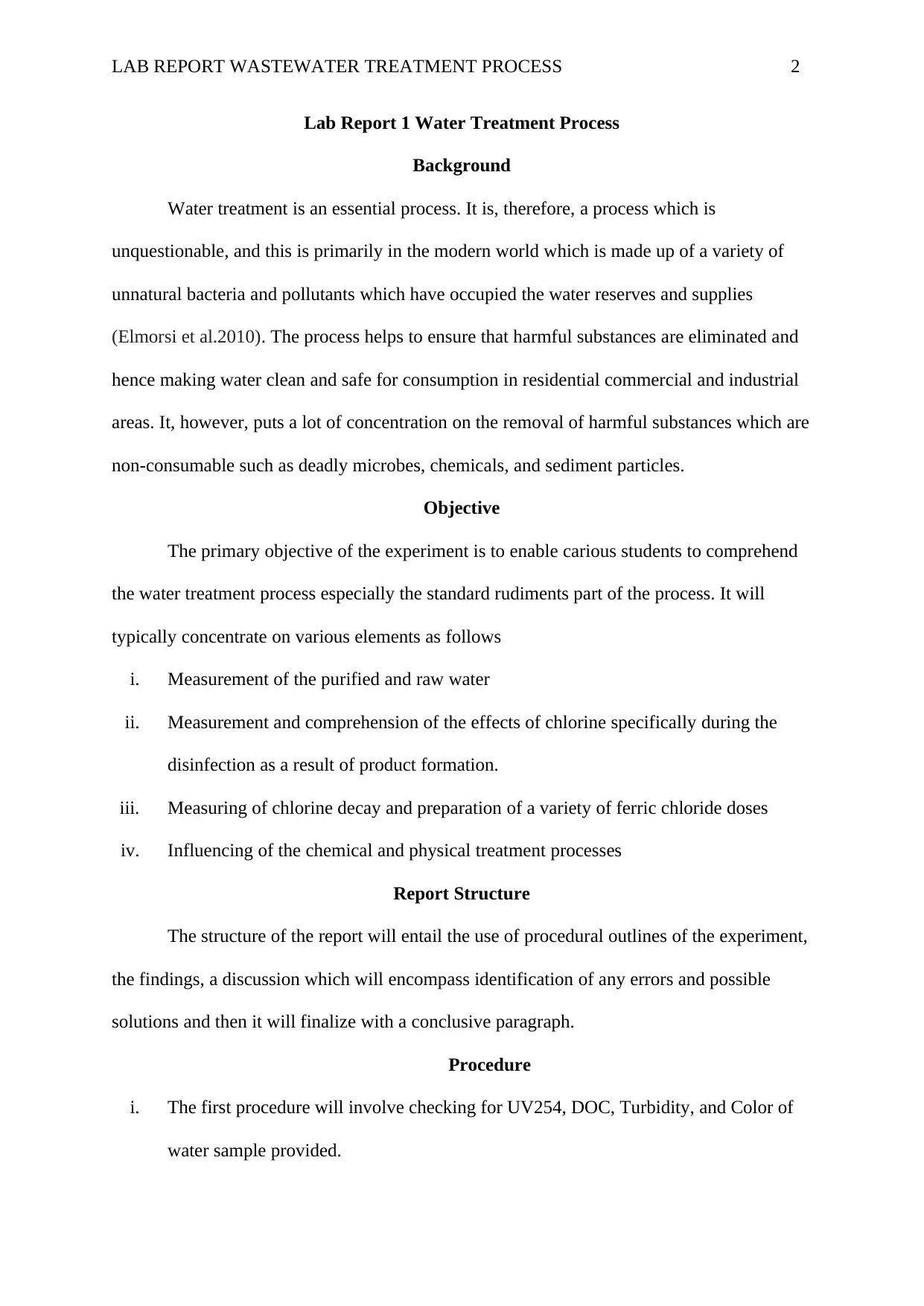
LAB REPORT WASTEWATER TREATMENT PROCESS 2
Lab Report 1 Water Treatment Process
Background
Water treatment is an essential process. It is, therefore, a process which is
unquestionable, and this is primarily in the modern world which is made up of a variety of
unnatural bacteria and pollutants which have occupied the water reserves and supplies
(Elmorsi et al.2010). The process helps to ensure that harmful substances are eliminated and
hence making water clean and safe for consumption in residential commercial and industrial
areas. It, however, puts a lot of concentration on the removal of harmful substances which are
non-consumable such as deadly microbes, chemicals, and sediment particles.
Objective
The primary objective of the experiment is to enable carious students to comprehend
the water treatment process especially the standard rudiments part of the process. It will
typically concentrate on various elements as follows
i. Measurement of the purified and raw water
ii. Measurement and comprehension of the effects of chlorine specifically during the
disinfection as a result of product formation.
iii. Measuring of chlorine decay and preparation of a variety of ferric chloride doses
iv. Influencing of the chemical and physical treatment processes
Report Structure
The structure of the report will entail the use of procedural outlines of the experiment,
the findings, a discussion which will encompass identification of any errors and possible
solutions and then it will finalize with a conclusive paragraph.
Procedure
i. The first procedure will involve checking for UV254, DOC, Turbidity, and Color of
water sample provided.
Lab Report 1 Water Treatment Process
Background
Water treatment is an essential process. It is, therefore, a process which is
unquestionable, and this is primarily in the modern world which is made up of a variety of
unnatural bacteria and pollutants which have occupied the water reserves and supplies
(Elmorsi et al.2010). The process helps to ensure that harmful substances are eliminated and
hence making water clean and safe for consumption in residential commercial and industrial
areas. It, however, puts a lot of concentration on the removal of harmful substances which are
non-consumable such as deadly microbes, chemicals, and sediment particles.
Objective
The primary objective of the experiment is to enable carious students to comprehend
the water treatment process especially the standard rudiments part of the process. It will
typically concentrate on various elements as follows
i. Measurement of the purified and raw water
ii. Measurement and comprehension of the effects of chlorine specifically during the
disinfection as a result of product formation.
iii. Measuring of chlorine decay and preparation of a variety of ferric chloride doses
iv. Influencing of the chemical and physical treatment processes
Report Structure
The structure of the report will entail the use of procedural outlines of the experiment,
the findings, a discussion which will encompass identification of any errors and possible
solutions and then it will finalize with a conclusive paragraph.
Procedure
i. The first procedure will involve checking for UV254, DOC, Turbidity, and Color of
water sample provided.
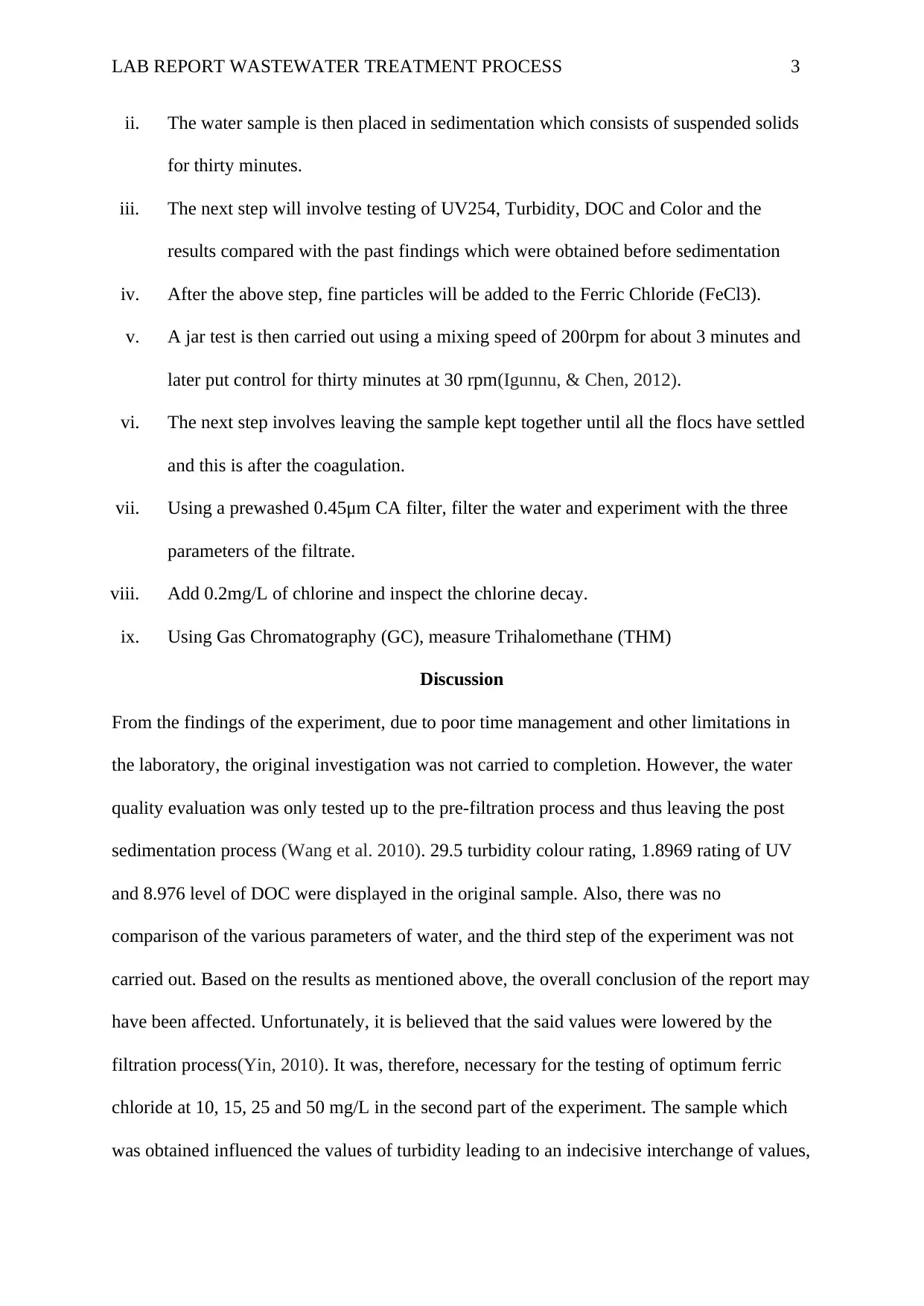
LAB REPORT WASTEWATER TREATMENT PROCESS 3
ii. The water sample is then placed in sedimentation which consists of suspended solids
for thirty minutes.
iii. The next step will involve testing of UV254, Turbidity, DOC and Color and the
results compared with the past findings which were obtained before sedimentation
iv. After the above step, fine particles will be added to the Ferric Chloride (FeCl3).
v. A jar test is then carried out using a mixing speed of 200rpm for about 3 minutes and
later put control for thirty minutes at 30 rpm(Igunnu, & Chen, 2012).
vi. The next step involves leaving the sample kept together until all the flocs have settled
and this is after the coagulation.
vii. Using a prewashed 0.45μm CA filter, filter the water and experiment with the three
parameters of the filtrate.
viii. Add 0.2mg/L of chlorine and inspect the chlorine decay.
ix. Using Gas Chromatography (GC), measure Trihalomethane (THM)
Discussion
From the findings of the experiment, due to poor time management and other limitations in
the laboratory, the original investigation was not carried to completion. However, the water
quality evaluation was only tested up to the pre-filtration process and thus leaving the post
sedimentation process (Wang et al. 2010). 29.5 turbidity colour rating, 1.8969 rating of UV
and 8.976 level of DOC were displayed in the original sample. Also, there was no
comparison of the various parameters of water, and the third step of the experiment was not
carried out. Based on the results as mentioned above, the overall conclusion of the report may
have been affected. Unfortunately, it is believed that the said values were lowered by the
filtration process(Yin, 2010). It was, therefore, necessary for the testing of optimum ferric
chloride at 10, 15, 25 and 50 mg/L in the second part of the experiment. The sample which
was obtained influenced the values of turbidity leading to an indecisive interchange of values,
ii. The water sample is then placed in sedimentation which consists of suspended solids
for thirty minutes.
iii. The next step will involve testing of UV254, Turbidity, DOC and Color and the
results compared with the past findings which were obtained before sedimentation
iv. After the above step, fine particles will be added to the Ferric Chloride (FeCl3).
v. A jar test is then carried out using a mixing speed of 200rpm for about 3 minutes and
later put control for thirty minutes at 30 rpm(Igunnu, & Chen, 2012).
vi. The next step involves leaving the sample kept together until all the flocs have settled
and this is after the coagulation.
vii. Using a prewashed 0.45μm CA filter, filter the water and experiment with the three
parameters of the filtrate.
viii. Add 0.2mg/L of chlorine and inspect the chlorine decay.
ix. Using Gas Chromatography (GC), measure Trihalomethane (THM)
Discussion
From the findings of the experiment, due to poor time management and other limitations in
the laboratory, the original investigation was not carried to completion. However, the water
quality evaluation was only tested up to the pre-filtration process and thus leaving the post
sedimentation process (Wang et al. 2010). 29.5 turbidity colour rating, 1.8969 rating of UV
and 8.976 level of DOC were displayed in the original sample. Also, there was no
comparison of the various parameters of water, and the third step of the experiment was not
carried out. Based on the results as mentioned above, the overall conclusion of the report may
have been affected. Unfortunately, it is believed that the said values were lowered by the
filtration process(Yin, 2010). It was, therefore, necessary for the testing of optimum ferric
chloride at 10, 15, 25 and 50 mg/L in the second part of the experiment. The sample which
was obtained influenced the values of turbidity leading to an indecisive interchange of values,
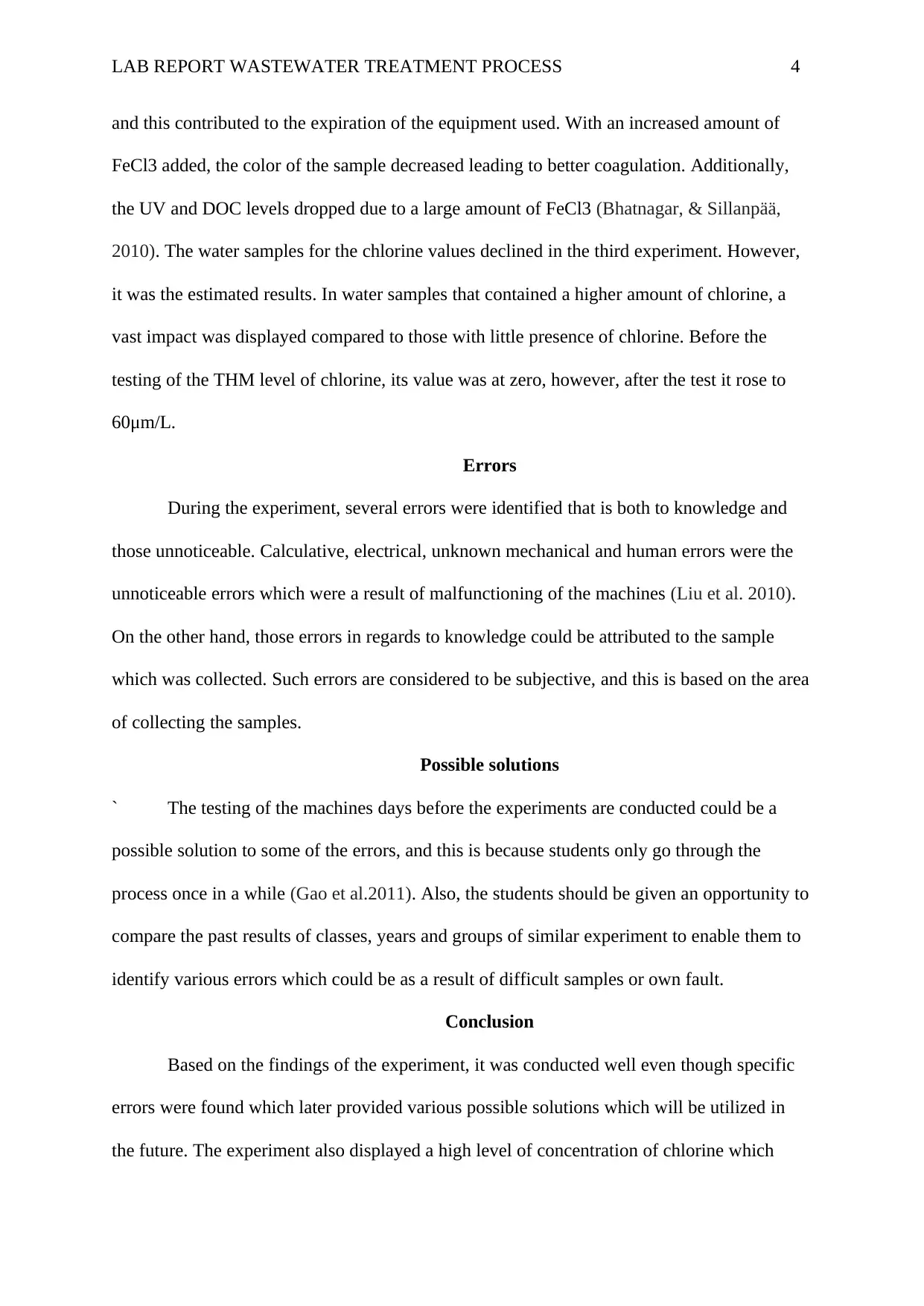
LAB REPORT WASTEWATER TREATMENT PROCESS 4
and this contributed to the expiration of the equipment used. With an increased amount of
FeCl3 added, the color of the sample decreased leading to better coagulation. Additionally,
the UV and DOC levels dropped due to a large amount of FeCl3 (Bhatnagar, & Sillanpää,
2010). The water samples for the chlorine values declined in the third experiment. However,
it was the estimated results. In water samples that contained a higher amount of chlorine, a
vast impact was displayed compared to those with little presence of chlorine. Before the
testing of the THM level of chlorine, its value was at zero, however, after the test it rose to
60μm/L.
Errors
During the experiment, several errors were identified that is both to knowledge and
those unnoticeable. Calculative, electrical, unknown mechanical and human errors were the
unnoticeable errors which were a result of malfunctioning of the machines (Liu et al. 2010).
On the other hand, those errors in regards to knowledge could be attributed to the sample
which was collected. Such errors are considered to be subjective, and this is based on the area
of collecting the samples.
Possible solutions
` The testing of the machines days before the experiments are conducted could be a
possible solution to some of the errors, and this is because students only go through the
process once in a while (Gao et al.2011). Also, the students should be given an opportunity to
compare the past results of classes, years and groups of similar experiment to enable them to
identify various errors which could be as a result of difficult samples or own fault.
Conclusion
Based on the findings of the experiment, it was conducted well even though specific
errors were found which later provided various possible solutions which will be utilized in
the future. The experiment also displayed a high level of concentration of chlorine which
and this contributed to the expiration of the equipment used. With an increased amount of
FeCl3 added, the color of the sample decreased leading to better coagulation. Additionally,
the UV and DOC levels dropped due to a large amount of FeCl3 (Bhatnagar, & Sillanpää,
2010). The water samples for the chlorine values declined in the third experiment. However,
it was the estimated results. In water samples that contained a higher amount of chlorine, a
vast impact was displayed compared to those with little presence of chlorine. Before the
testing of the THM level of chlorine, its value was at zero, however, after the test it rose to
60μm/L.
Errors
During the experiment, several errors were identified that is both to knowledge and
those unnoticeable. Calculative, electrical, unknown mechanical and human errors were the
unnoticeable errors which were a result of malfunctioning of the machines (Liu et al. 2010).
On the other hand, those errors in regards to knowledge could be attributed to the sample
which was collected. Such errors are considered to be subjective, and this is based on the area
of collecting the samples.
Possible solutions
` The testing of the machines days before the experiments are conducted could be a
possible solution to some of the errors, and this is because students only go through the
process once in a while (Gao et al.2011). Also, the students should be given an opportunity to
compare the past results of classes, years and groups of similar experiment to enable them to
identify various errors which could be as a result of difficult samples or own fault.
Conclusion
Based on the findings of the experiment, it was conducted well even though specific
errors were found which later provided various possible solutions which will be utilized in
the future. The experiment also displayed a high level of concentration of chlorine which
Secure Best Marks with AI Grader
Need help grading? Try our AI Grader for instant feedback on your assignments.
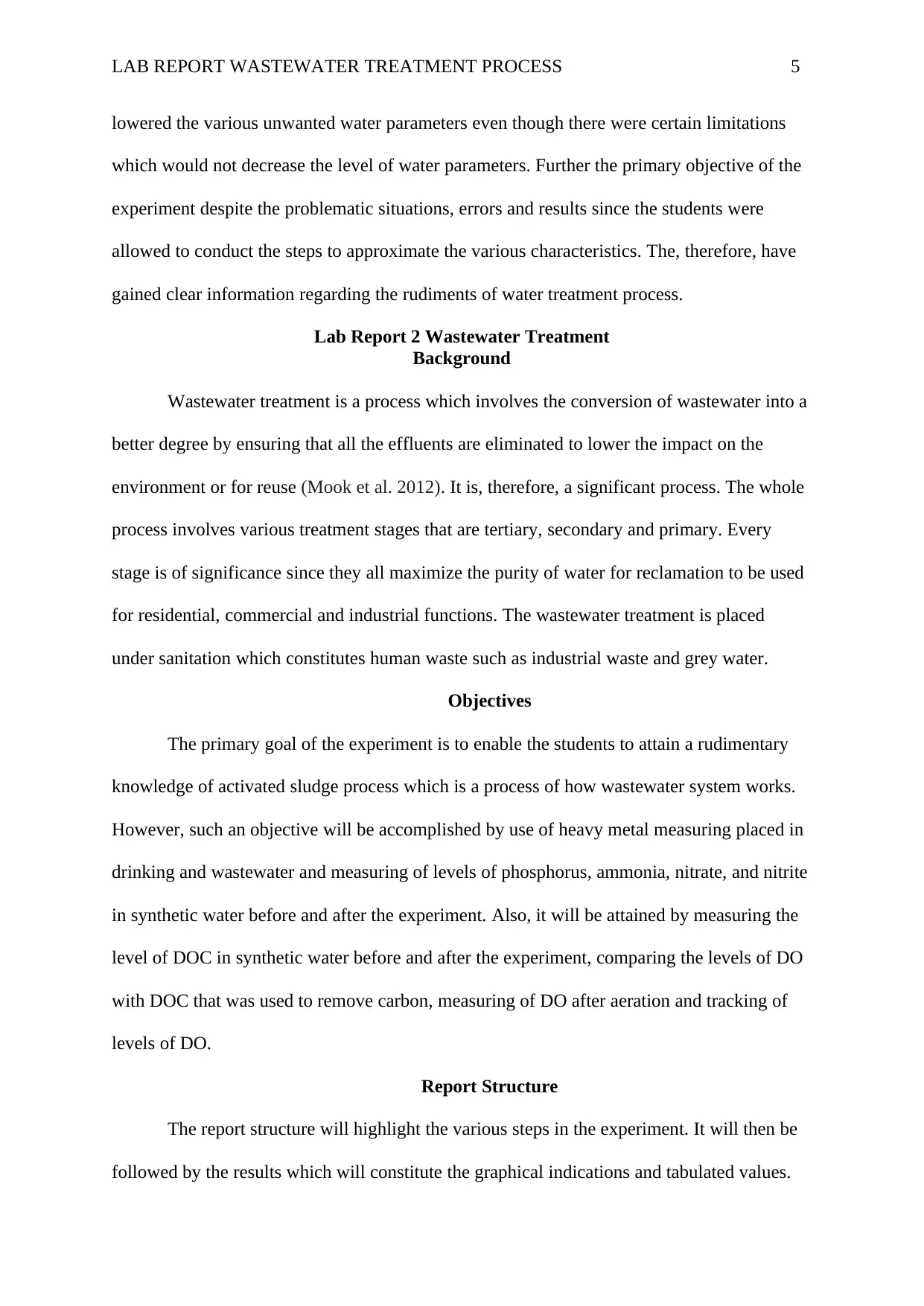
LAB REPORT WASTEWATER TREATMENT PROCESS 5
lowered the various unwanted water parameters even though there were certain limitations
which would not decrease the level of water parameters. Further the primary objective of the
experiment despite the problematic situations, errors and results since the students were
allowed to conduct the steps to approximate the various characteristics. The, therefore, have
gained clear information regarding the rudiments of water treatment process.
Lab Report 2 Wastewater Treatment
Background
Wastewater treatment is a process which involves the conversion of wastewater into a
better degree by ensuring that all the effluents are eliminated to lower the impact on the
environment or for reuse (Mook et al. 2012). It is, therefore, a significant process. The whole
process involves various treatment stages that are tertiary, secondary and primary. Every
stage is of significance since they all maximize the purity of water for reclamation to be used
for residential, commercial and industrial functions. The wastewater treatment is placed
under sanitation which constitutes human waste such as industrial waste and grey water.
Objectives
The primary goal of the experiment is to enable the students to attain a rudimentary
knowledge of activated sludge process which is a process of how wastewater system works.
However, such an objective will be accomplished by use of heavy metal measuring placed in
drinking and wastewater and measuring of levels of phosphorus, ammonia, nitrate, and nitrite
in synthetic water before and after the experiment. Also, it will be attained by measuring the
level of DOC in synthetic water before and after the experiment, comparing the levels of DO
with DOC that was used to remove carbon, measuring of DO after aeration and tracking of
levels of DO.
Report Structure
The report structure will highlight the various steps in the experiment. It will then be
followed by the results which will constitute the graphical indications and tabulated values.
lowered the various unwanted water parameters even though there were certain limitations
which would not decrease the level of water parameters. Further the primary objective of the
experiment despite the problematic situations, errors and results since the students were
allowed to conduct the steps to approximate the various characteristics. The, therefore, have
gained clear information regarding the rudiments of water treatment process.
Lab Report 2 Wastewater Treatment
Background
Wastewater treatment is a process which involves the conversion of wastewater into a
better degree by ensuring that all the effluents are eliminated to lower the impact on the
environment or for reuse (Mook et al. 2012). It is, therefore, a significant process. The whole
process involves various treatment stages that are tertiary, secondary and primary. Every
stage is of significance since they all maximize the purity of water for reclamation to be used
for residential, commercial and industrial functions. The wastewater treatment is placed
under sanitation which constitutes human waste such as industrial waste and grey water.
Objectives
The primary goal of the experiment is to enable the students to attain a rudimentary
knowledge of activated sludge process which is a process of how wastewater system works.
However, such an objective will be accomplished by use of heavy metal measuring placed in
drinking and wastewater and measuring of levels of phosphorus, ammonia, nitrate, and nitrite
in synthetic water before and after the experiment. Also, it will be attained by measuring the
level of DOC in synthetic water before and after the experiment, comparing the levels of DO
with DOC that was used to remove carbon, measuring of DO after aeration and tracking of
levels of DO.
Report Structure
The report structure will highlight the various steps in the experiment. It will then be
followed by the results which will constitute the graphical indications and tabulated values.
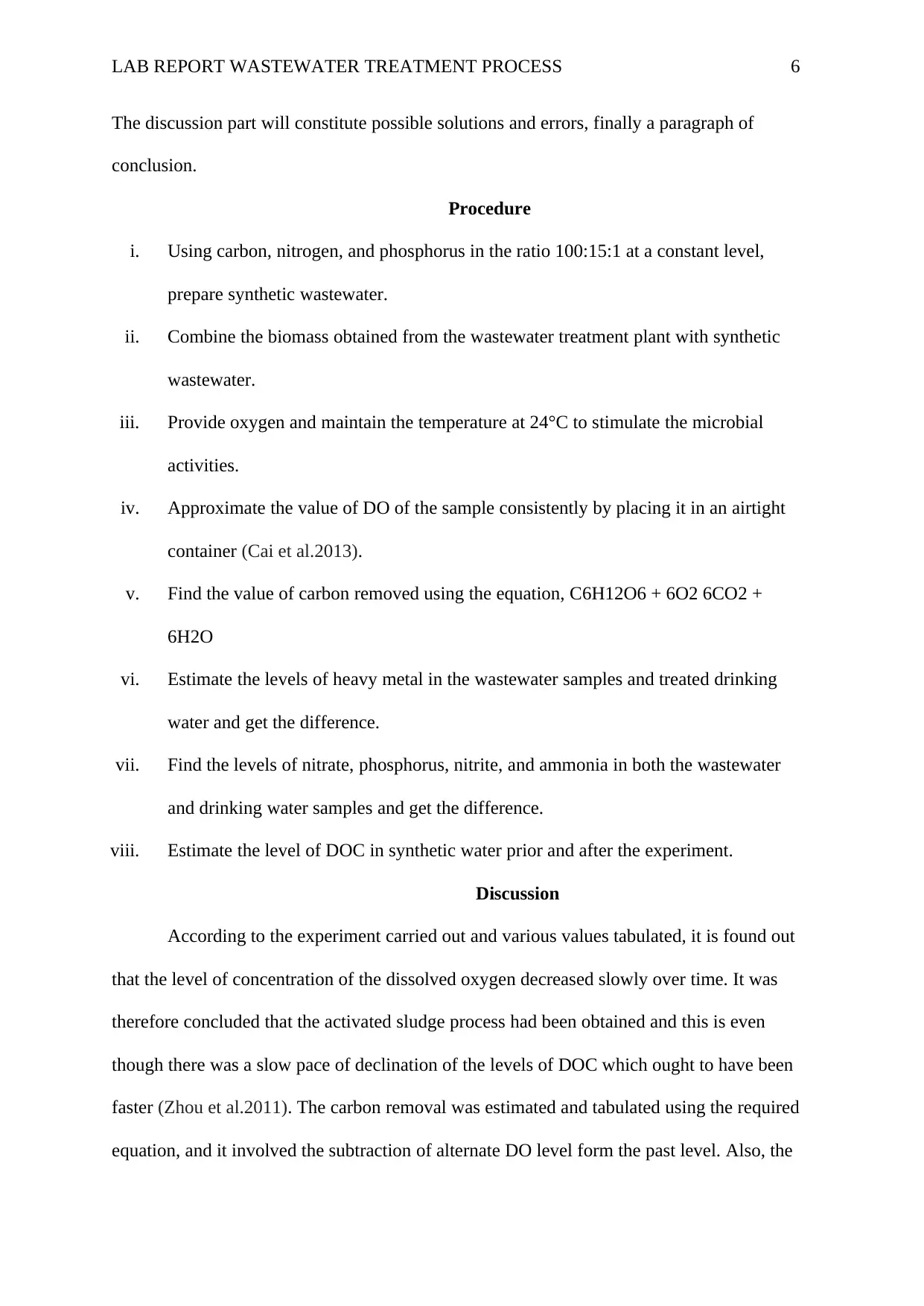
LAB REPORT WASTEWATER TREATMENT PROCESS 6
The discussion part will constitute possible solutions and errors, finally a paragraph of
conclusion.
Procedure
i. Using carbon, nitrogen, and phosphorus in the ratio 100:15:1 at a constant level,
prepare synthetic wastewater.
ii. Combine the biomass obtained from the wastewater treatment plant with synthetic
wastewater.
iii. Provide oxygen and maintain the temperature at 24°C to stimulate the microbial
activities.
iv. Approximate the value of DO of the sample consistently by placing it in an airtight
container (Cai et al.2013).
v. Find the value of carbon removed using the equation, C6H12O6 + 6O2 6CO2 +
6H2O
vi. Estimate the levels of heavy metal in the wastewater samples and treated drinking
water and get the difference.
vii. Find the levels of nitrate, phosphorus, nitrite, and ammonia in both the wastewater
and drinking water samples and get the difference.
viii. Estimate the level of DOC in synthetic water prior and after the experiment.
Discussion
According to the experiment carried out and various values tabulated, it is found out
that the level of concentration of the dissolved oxygen decreased slowly over time. It was
therefore concluded that the activated sludge process had been obtained and this is even
though there was a slow pace of declination of the levels of DOC which ought to have been
faster (Zhou et al.2011). The carbon removal was estimated and tabulated using the required
equation, and it involved the subtraction of alternate DO level form the past level. Also, the
The discussion part will constitute possible solutions and errors, finally a paragraph of
conclusion.
Procedure
i. Using carbon, nitrogen, and phosphorus in the ratio 100:15:1 at a constant level,
prepare synthetic wastewater.
ii. Combine the biomass obtained from the wastewater treatment plant with synthetic
wastewater.
iii. Provide oxygen and maintain the temperature at 24°C to stimulate the microbial
activities.
iv. Approximate the value of DO of the sample consistently by placing it in an airtight
container (Cai et al.2013).
v. Find the value of carbon removed using the equation, C6H12O6 + 6O2 6CO2 +
6H2O
vi. Estimate the levels of heavy metal in the wastewater samples and treated drinking
water and get the difference.
vii. Find the levels of nitrate, phosphorus, nitrite, and ammonia in both the wastewater
and drinking water samples and get the difference.
viii. Estimate the level of DOC in synthetic water prior and after the experiment.
Discussion
According to the experiment carried out and various values tabulated, it is found out
that the level of concentration of the dissolved oxygen decreased slowly over time. It was
therefore concluded that the activated sludge process had been obtained and this is even
though there was a slow pace of declination of the levels of DOC which ought to have been
faster (Zhou et al.2011). The carbon removal was estimated and tabulated using the required
equation, and it involved the subtraction of alternate DO level form the past level. Also, the
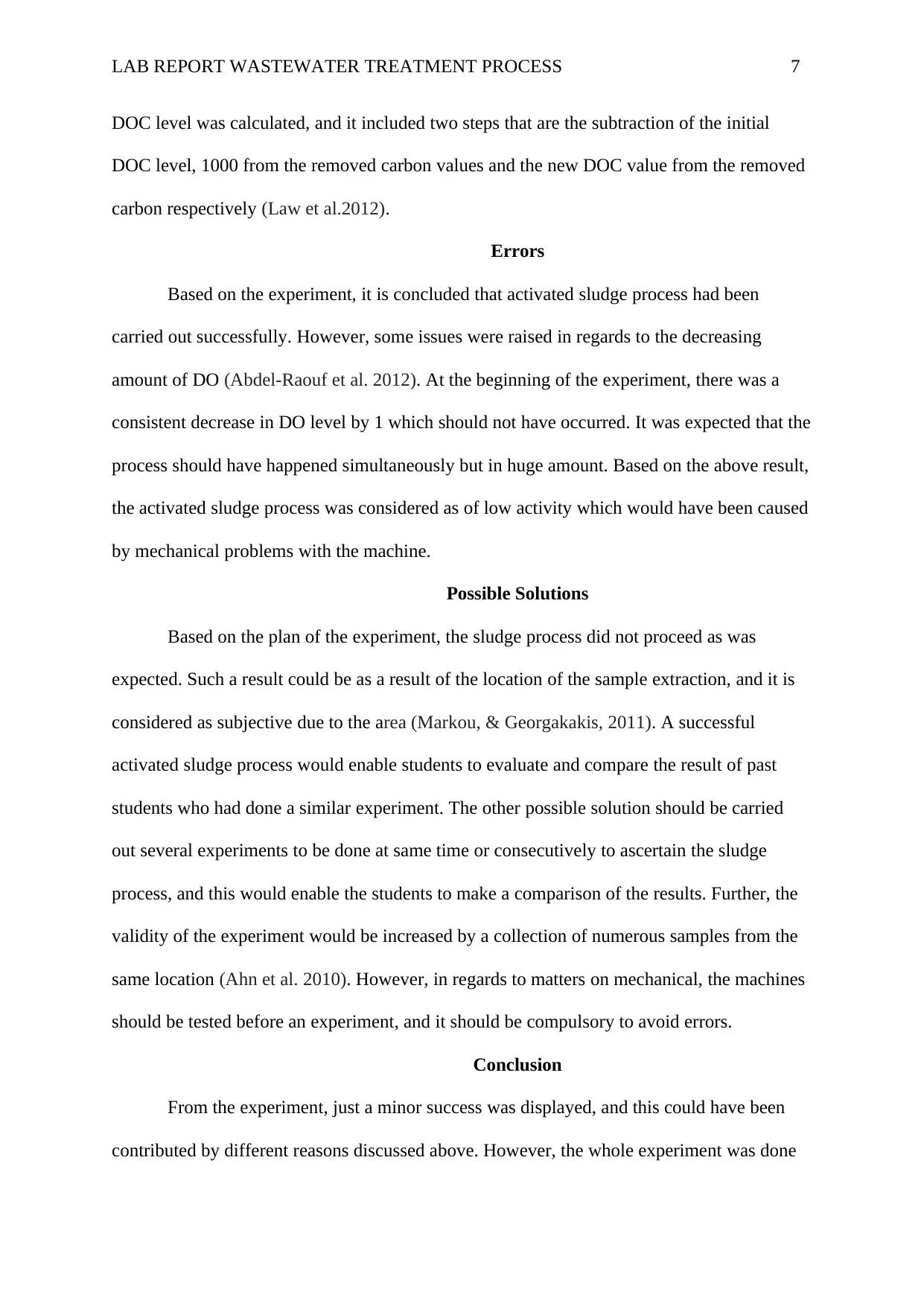
LAB REPORT WASTEWATER TREATMENT PROCESS 7
DOC level was calculated, and it included two steps that are the subtraction of the initial
DOC level, 1000 from the removed carbon values and the new DOC value from the removed
carbon respectively (Law et al.2012).
Errors
Based on the experiment, it is concluded that activated sludge process had been
carried out successfully. However, some issues were raised in regards to the decreasing
amount of DO (Abdel-Raouf et al. 2012). At the beginning of the experiment, there was a
consistent decrease in DO level by 1 which should not have occurred. It was expected that the
process should have happened simultaneously but in huge amount. Based on the above result,
the activated sludge process was considered as of low activity which would have been caused
by mechanical problems with the machine.
Possible Solutions
Based on the plan of the experiment, the sludge process did not proceed as was
expected. Such a result could be as a result of the location of the sample extraction, and it is
considered as subjective due to the area (Markou, & Georgakakis, 2011). A successful
activated sludge process would enable students to evaluate and compare the result of past
students who had done a similar experiment. The other possible solution should be carried
out several experiments to be done at same time or consecutively to ascertain the sludge
process, and this would enable the students to make a comparison of the results. Further, the
validity of the experiment would be increased by a collection of numerous samples from the
same location (Ahn et al. 2010). However, in regards to matters on mechanical, the machines
should be tested before an experiment, and it should be compulsory to avoid errors.
Conclusion
From the experiment, just a minor success was displayed, and this could have been
contributed by different reasons discussed above. However, the whole experiment was done
DOC level was calculated, and it included two steps that are the subtraction of the initial
DOC level, 1000 from the removed carbon values and the new DOC value from the removed
carbon respectively (Law et al.2012).
Errors
Based on the experiment, it is concluded that activated sludge process had been
carried out successfully. However, some issues were raised in regards to the decreasing
amount of DO (Abdel-Raouf et al. 2012). At the beginning of the experiment, there was a
consistent decrease in DO level by 1 which should not have occurred. It was expected that the
process should have happened simultaneously but in huge amount. Based on the above result,
the activated sludge process was considered as of low activity which would have been caused
by mechanical problems with the machine.
Possible Solutions
Based on the plan of the experiment, the sludge process did not proceed as was
expected. Such a result could be as a result of the location of the sample extraction, and it is
considered as subjective due to the area (Markou, & Georgakakis, 2011). A successful
activated sludge process would enable students to evaluate and compare the result of past
students who had done a similar experiment. The other possible solution should be carried
out several experiments to be done at same time or consecutively to ascertain the sludge
process, and this would enable the students to make a comparison of the results. Further, the
validity of the experiment would be increased by a collection of numerous samples from the
same location (Ahn et al. 2010). However, in regards to matters on mechanical, the machines
should be tested before an experiment, and it should be compulsory to avoid errors.
Conclusion
From the experiment, just a minor success was displayed, and this could have been
contributed by different reasons discussed above. However, the whole experiment was done
Paraphrase This Document
Need a fresh take? Get an instant paraphrase of this document with our AI Paraphraser
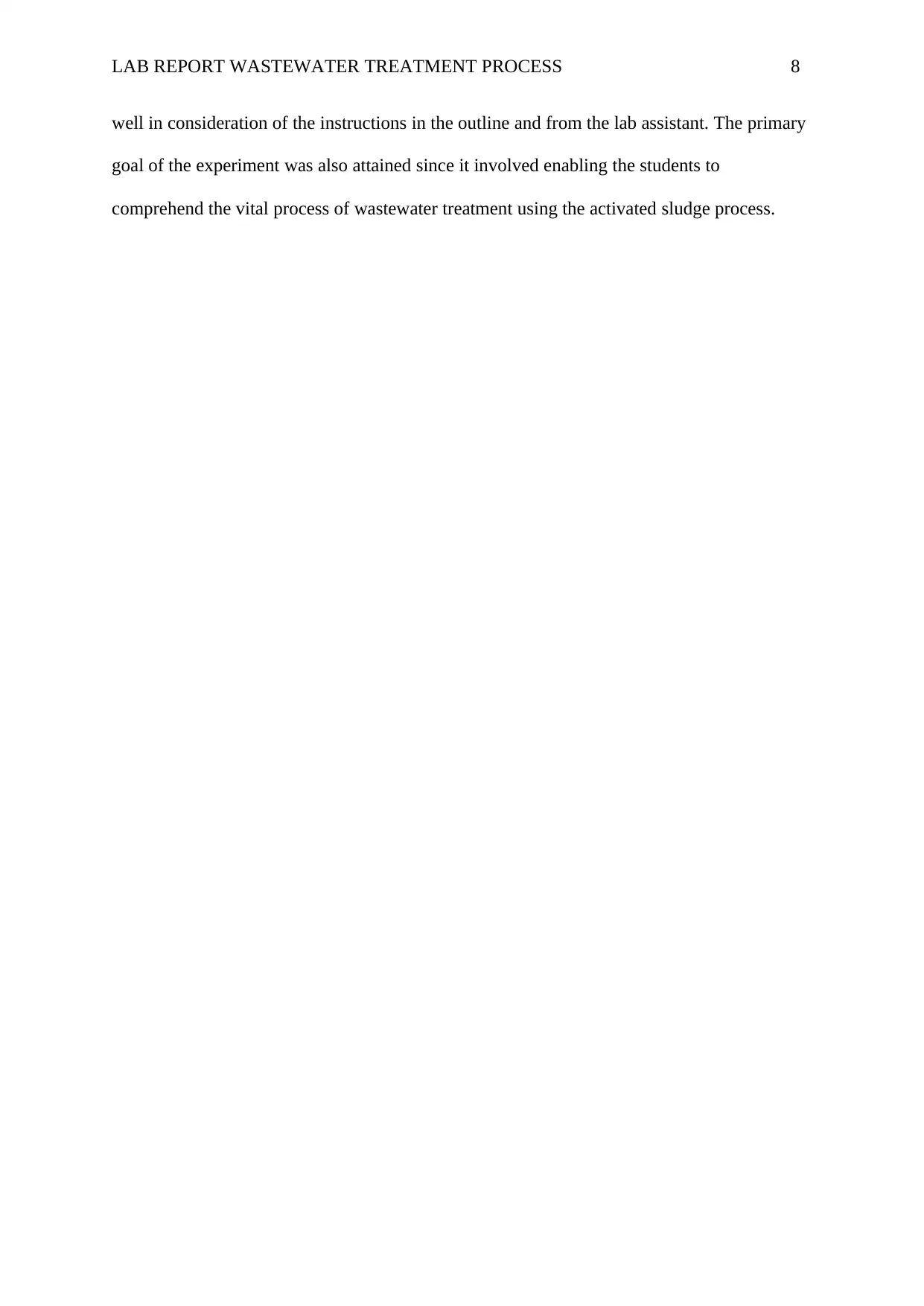
LAB REPORT WASTEWATER TREATMENT PROCESS 8
well in consideration of the instructions in the outline and from the lab assistant. The primary
goal of the experiment was also attained since it involved enabling the students to
comprehend the vital process of wastewater treatment using the activated sludge process.
well in consideration of the instructions in the outline and from the lab assistant. The primary
goal of the experiment was also attained since it involved enabling the students to
comprehend the vital process of wastewater treatment using the activated sludge process.
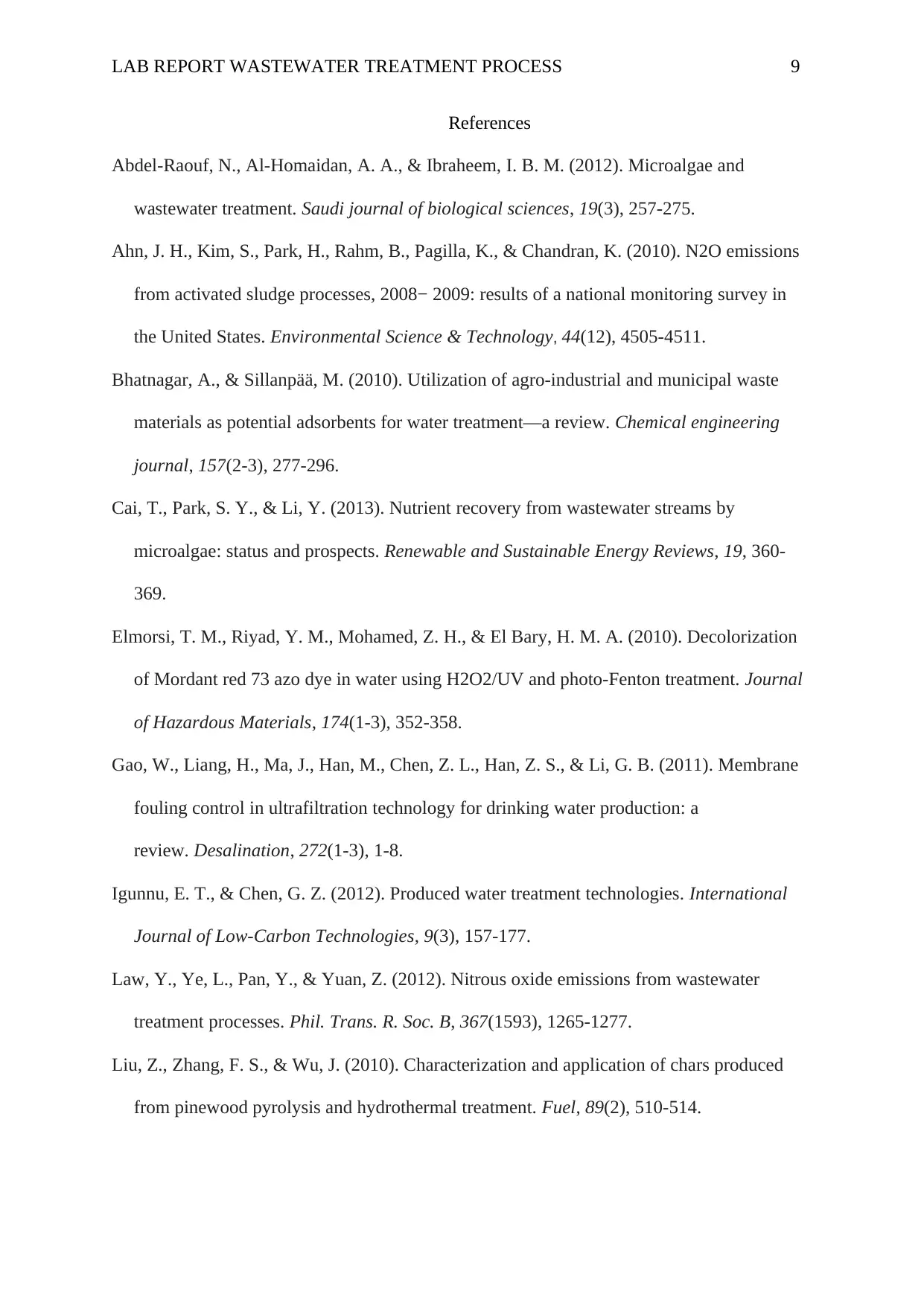
LAB REPORT WASTEWATER TREATMENT PROCESS 9
References
Abdel-Raouf, N., Al-Homaidan, A. A., & Ibraheem, I. B. M. (2012). Microalgae and
wastewater treatment. Saudi journal of biological sciences, 19(3), 257-275.
Ahn, J. H., Kim, S., Park, H., Rahm, B., Pagilla, K., & Chandran, K. (2010). N2O emissions
from activated sludge processes, 2008− 2009: results of a national monitoring survey in
the United States. Environmental Science & Technology, 44(12), 4505-4511.
Bhatnagar, A., & Sillanpää, M. (2010). Utilization of agro-industrial and municipal waste
materials as potential adsorbents for water treatment—a review. Chemical engineering
journal, 157(2-3), 277-296.
Cai, T., Park, S. Y., & Li, Y. (2013). Nutrient recovery from wastewater streams by
microalgae: status and prospects. Renewable and Sustainable Energy Reviews, 19, 360-
369.
Elmorsi, T. M., Riyad, Y. M., Mohamed, Z. H., & El Bary, H. M. A. (2010). Decolorization
of Mordant red 73 azo dye in water using H2O2/UV and photo-Fenton treatment. Journal
of Hazardous Materials, 174(1-3), 352-358.
Gao, W., Liang, H., Ma, J., Han, M., Chen, Z. L., Han, Z. S., & Li, G. B. (2011). Membrane
fouling control in ultrafiltration technology for drinking water production: a
review. Desalination, 272(1-3), 1-8.
Igunnu, E. T., & Chen, G. Z. (2012). Produced water treatment technologies. International
Journal of Low-Carbon Technologies, 9(3), 157-177.
Law, Y., Ye, L., Pan, Y., & Yuan, Z. (2012). Nitrous oxide emissions from wastewater
treatment processes. Phil. Trans. R. Soc. B, 367(1593), 1265-1277.
Liu, Z., Zhang, F. S., & Wu, J. (2010). Characterization and application of chars produced
from pinewood pyrolysis and hydrothermal treatment. Fuel, 89(2), 510-514.
References
Abdel-Raouf, N., Al-Homaidan, A. A., & Ibraheem, I. B. M. (2012). Microalgae and
wastewater treatment. Saudi journal of biological sciences, 19(3), 257-275.
Ahn, J. H., Kim, S., Park, H., Rahm, B., Pagilla, K., & Chandran, K. (2010). N2O emissions
from activated sludge processes, 2008− 2009: results of a national monitoring survey in
the United States. Environmental Science & Technology, 44(12), 4505-4511.
Bhatnagar, A., & Sillanpää, M. (2010). Utilization of agro-industrial and municipal waste
materials as potential adsorbents for water treatment—a review. Chemical engineering
journal, 157(2-3), 277-296.
Cai, T., Park, S. Y., & Li, Y. (2013). Nutrient recovery from wastewater streams by
microalgae: status and prospects. Renewable and Sustainable Energy Reviews, 19, 360-
369.
Elmorsi, T. M., Riyad, Y. M., Mohamed, Z. H., & El Bary, H. M. A. (2010). Decolorization
of Mordant red 73 azo dye in water using H2O2/UV and photo-Fenton treatment. Journal
of Hazardous Materials, 174(1-3), 352-358.
Gao, W., Liang, H., Ma, J., Han, M., Chen, Z. L., Han, Z. S., & Li, G. B. (2011). Membrane
fouling control in ultrafiltration technology for drinking water production: a
review. Desalination, 272(1-3), 1-8.
Igunnu, E. T., & Chen, G. Z. (2012). Produced water treatment technologies. International
Journal of Low-Carbon Technologies, 9(3), 157-177.
Law, Y., Ye, L., Pan, Y., & Yuan, Z. (2012). Nitrous oxide emissions from wastewater
treatment processes. Phil. Trans. R. Soc. B, 367(1593), 1265-1277.
Liu, Z., Zhang, F. S., & Wu, J. (2010). Characterization and application of chars produced
from pinewood pyrolysis and hydrothermal treatment. Fuel, 89(2), 510-514.
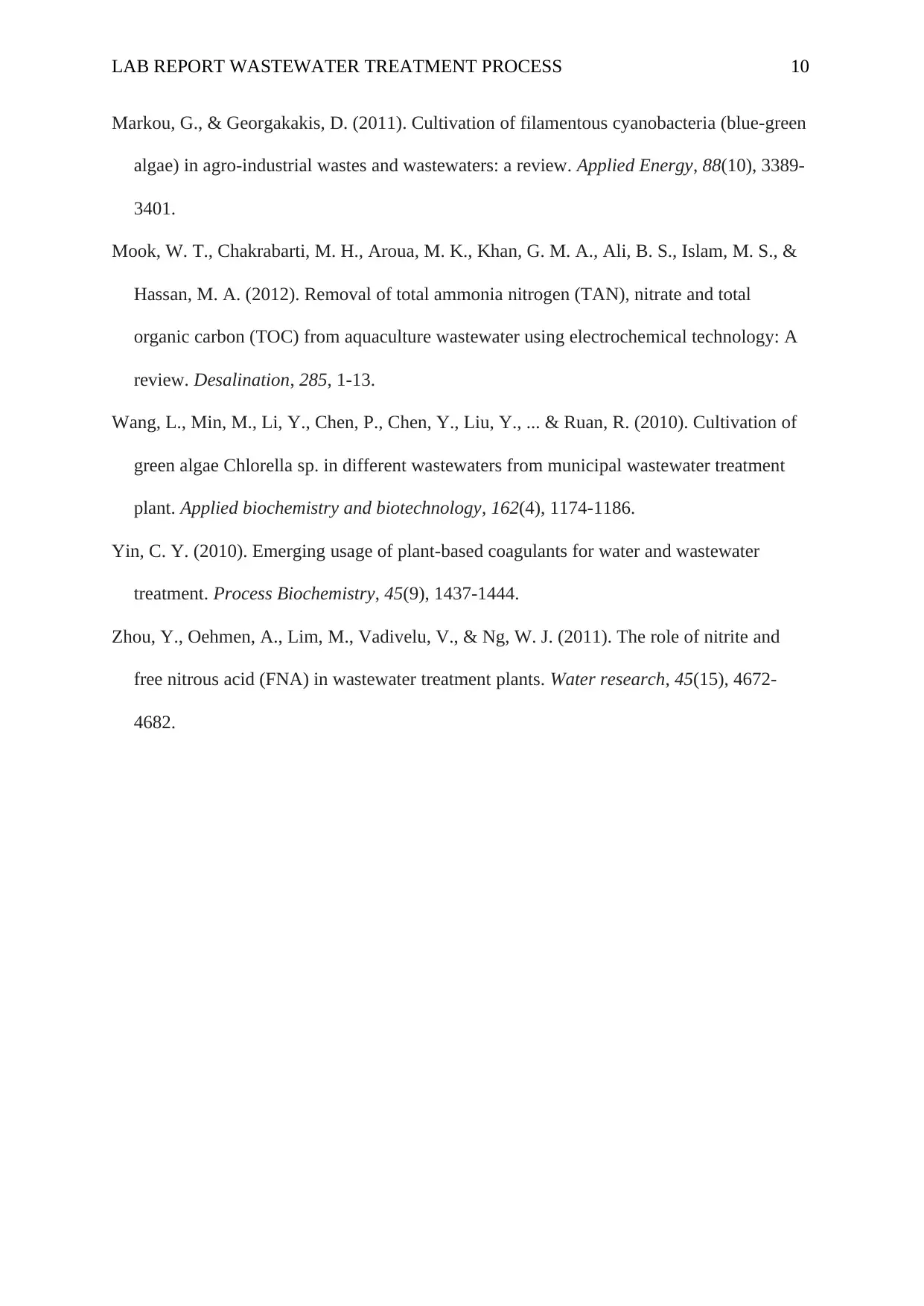
LAB REPORT WASTEWATER TREATMENT PROCESS 10
Markou, G., & Georgakakis, D. (2011). Cultivation of filamentous cyanobacteria (blue-green
algae) in agro-industrial wastes and wastewaters: a review. Applied Energy, 88(10), 3389-
3401.
Mook, W. T., Chakrabarti, M. H., Aroua, M. K., Khan, G. M. A., Ali, B. S., Islam, M. S., &
Hassan, M. A. (2012). Removal of total ammonia nitrogen (TAN), nitrate and total
organic carbon (TOC) from aquaculture wastewater using electrochemical technology: A
review. Desalination, 285, 1-13.
Wang, L., Min, M., Li, Y., Chen, P., Chen, Y., Liu, Y., ... & Ruan, R. (2010). Cultivation of
green algae Chlorella sp. in different wastewaters from municipal wastewater treatment
plant. Applied biochemistry and biotechnology, 162(4), 1174-1186.
Yin, C. Y. (2010). Emerging usage of plant-based coagulants for water and wastewater
treatment. Process Biochemistry, 45(9), 1437-1444.
Zhou, Y., Oehmen, A., Lim, M., Vadivelu, V., & Ng, W. J. (2011). The role of nitrite and
free nitrous acid (FNA) in wastewater treatment plants. Water research, 45(15), 4672-
4682.
Markou, G., & Georgakakis, D. (2011). Cultivation of filamentous cyanobacteria (blue-green
algae) in agro-industrial wastes and wastewaters: a review. Applied Energy, 88(10), 3389-
3401.
Mook, W. T., Chakrabarti, M. H., Aroua, M. K., Khan, G. M. A., Ali, B. S., Islam, M. S., &
Hassan, M. A. (2012). Removal of total ammonia nitrogen (TAN), nitrate and total
organic carbon (TOC) from aquaculture wastewater using electrochemical technology: A
review. Desalination, 285, 1-13.
Wang, L., Min, M., Li, Y., Chen, P., Chen, Y., Liu, Y., ... & Ruan, R. (2010). Cultivation of
green algae Chlorella sp. in different wastewaters from municipal wastewater treatment
plant. Applied biochemistry and biotechnology, 162(4), 1174-1186.
Yin, C. Y. (2010). Emerging usage of plant-based coagulants for water and wastewater
treatment. Process Biochemistry, 45(9), 1437-1444.
Zhou, Y., Oehmen, A., Lim, M., Vadivelu, V., & Ng, W. J. (2011). The role of nitrite and
free nitrous acid (FNA) in wastewater treatment plants. Water research, 45(15), 4672-
4682.
1 out of 10
Your All-in-One AI-Powered Toolkit for Academic Success.
+13062052269
info@desklib.com
Available 24*7 on WhatsApp / Email
![[object Object]](/_next/static/media/star-bottom.7253800d.svg)
Unlock your academic potential
© 2024 | Zucol Services PVT LTD | All rights reserved.


